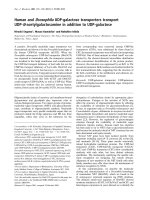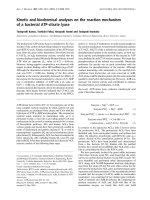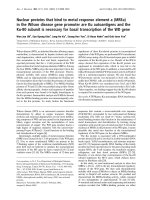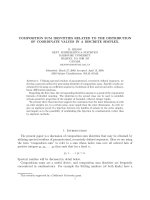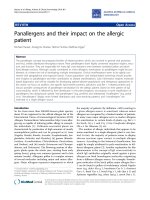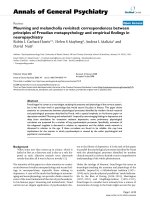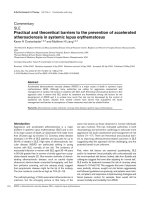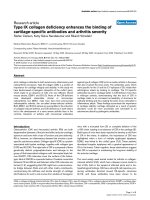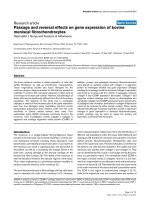Báo cáo y học: "Practical and theoretical barriers to the prevention of accelerated atherosclerosis in systemic lupus erythematosus" docx
Bạn đang xem bản rút gọn của tài liệu. Xem và tải ngay bản đầy đủ của tài liệu tại đây (34.98 KB, 2 trang )
178
ASVD = atherosclerotic vascular disease; SLE = systemic lupus erythematosus.
Arthritis Research & Therapy Vol 5 No 4 Costenbader and Liang
Introduction
Aggressive and accelerated atherosclerosis is a major
problem in systemic lupus erythematosus (SLE) and is one
of its major causes of death, an observation first made more
than 20 years ago by Urowitz [1]. Coronary artery disease
develops in 6–9% of SLE patients and accounts for up to
36.4% of deaths in SLE. High rates of atherosclerotic vas-
cular disease (ASVD) are particularly striking in young
women with SLE, normally at low risk. The incidence of
myocardial infarction in women with SLE aged 35–44 years
is 50-fold greater than in women of similar ages from a pop-
ulation-based sample [2]. Non-invasive methods of demon-
strating atherosclerotic disease, such as carotid duplex
ultrasound, electron-beam computed tomography, and thal-
lium perfusion scanning, and one autopsy study, suggest
that symptomatic disease might be the tip of the iceberg.
The true incidence could be as high as 74% [3–10].
The pathophysiology of SLE-associated atherosclerosis is
unknown, but the emerging picture is that many of the
same risk factors as those observed in normal individuals
are also involved. This has motivated authorities in both
rheumatology and preventive cardiology to advocate more
aggressive risk factor assessment and management of risk
factors [11–17]. There are theoretical and practical barri-
ers to improving atherosclerosis-related outcomes in SLE
suggesting that this approach will be challenging, and the
potential benefit is yet unknown.
First, when risk factors are examined quantitatively, SLE
and/or its treatment (most probably with corticosteroids) are
the most important risk factors. Indeed, data from Esdaile and
colleagues suggest that even after adjusting for ‘normal risk’,
SLE and/or its treatment increases the risk of coronary artery
disease 5–10-fold [18]. This suggests that even if physicians
were perfectly virtuous, sought out risk factors aggressively
and followed guidelines scrupulously; and patients were toler-
ant, compliant, and responsive to lipid-lowering strategies and
blood pressure control, for example, there would still be
excess mortality and morbidity from ASVD.
Commentary
SLE
Practical and theoretical barriers to the prevention of accelerated
atherosclerosis in systemic lupus erythematosus
Karen H Costenbader
1,2,3
and Matthew H Liang
1,3,4
1
The Robert B. Brigham Arthritis and Musculoskeletal Disease Clinical Research Center, Brigham and Women’s Hospital, Boston, Massachusetts,
USA
2
Department of Medicine, Massachusetts General Hospital, Boston, Massachusetts, USA
3
Harvard Medical School, Boston, Massachusetts, USA
4
Department of Medicine, Brigham and Women’s Hospital, Boston, Massachusetts, USA
Corresponding author: Karen H Costenbader (e-mail: )
Received: 10 Mar 2003 Revisions requested: 4 Apr 2003 Revisions received: 24 Apr 2003 Accepted: 30 Apr 2003 Published: 23 May 2003
Arthritis Res Ther 2003, 5:178-179 (DOI 10.1186/ar773)
© 2003 BioMed Central Ltd (Print ISSN 1478-6354; Online ISSN 1478-6362)
Abstract
Accelerated atherosclerotic vascular disease (ASVD) is a major cause of death in systemic lupus
erythematosus (SLE). Although many authorities are calling for aggressive assessment and
management of cardiac risk factors in patients with SLE, both theoretical and practical barriers to this
approach exist. It seems that SLE and/or its treatment are themselves strong risk factors for the
development of ASVD and it is unclear how much this risk can be decreased by the control of
traditional risk factors. Studies from several centers have shown that suboptimal risk factor
management and barriers to acceptance of these measures must also be studied further.
Keywords: atherosclerosis, cardiac risk factor, coronary artery disease, systemic lupus erythematosus
179
Available online />Second, studies from Toronto and Baltimore show that
risk factor identification and, by implication, treatment fall
short of what one would predict from the importance of
the problem [13,19]. We know that patients with chronic
diseases such as SLE, rheumatoid arthritis, and diabetes
are less likely to receive the highest quality of preventive
health care, perhaps because more urgent problems must
be dealt with first, or perhaps because of patients’ and
physicians’ exhaustion in dealing with chronic health prob-
lems. Patients can find it difficult to change their lifestyles
and take additional medications on top of complicated
regimens or little reinforcement from their providers. In
recruiting patients with SLE and hyperlipidemia for a statin
dosing study, our experience has been that the patients
who are the most willing to participate are relatively young
and healthy, with very mild SLE, and few other health
problems or medications. Among those patients with more
long-standing and severe SLE, reasons for non-participa-
tion have included, ‘I’m flaring and don’t want to take
another medication that might make me sick’, ‘I’m trying to
get healthy’, and ‘I’m too sick and have too many doctor’s
appointments already’.
Conclusion
HL Mencken once quipped, ‘For every complex problem,
there is a solution which is simple, neat and wrong’. We
have known for over 20 years of the late complications of
SLE. The received wisdom that we need only try harder to
implement the known effective preventive strategies for
normal individuals is simple and neat, but might be wrong
or incomplete.
Several questions remain unanswered in our search for a
successful approach to the prevention of ASVD in SLE. The
etiologic factors responsible for vascular injury in SLE need
to be understood more precisely. For example, do short-
term hypertension, hyperlipidemia, and immune complex
generation of an SLE flare do as much or more damage to
the endothelium as does lower-grade inflammation or expo-
sure to traditional risk factors for many years? In addition, a
better understanding of patient social and cultural factors
will be essential to achieving acceptance of lifestyle
changes and medications. Progress will only be made as
basic science brings an understanding of the mechanisms
of accelerated atherosclerosis in SLE and as clinical studies
address both the efficacy and the effectiveness of existing
and improved risk factor control.
Competing interests
None declared.
Acknowledgements
KHC is supported by a Physician Scientist Development Award from
the Arthritis Foundation and American College of Rheumatology, and a
grant from the Arthritis National Research Foundation. MHL is sup-
ported by an NIH grant P60 AR47782 and by a Kirkland Scholar Award.
References
1. Urowitz MB, Bookman AAM, Koehler BE, Gordon DA, Smythe
HA, Ogryzlo MA: The bimodal mortality pattern of systemic
lupus erythematosus. Am J Med 1976, 60:221-225.
2. Manzi S, Meilahn EN, Rairie JE, Conte CG, Medsger TA Jr,
Jansen-McWilliams L, D’Agostino RB, Kuller LH: Age-specific
incidence rates of myocardial infarction and angina in women
with systemic lupus erythematosus: comparison with the
Framingham Study. Am J Epidemiol 1997, 145:408-415.
3. Badui E, Garcia-Rubi D, Robles E, Jimenez J, Juan L, Deleze M,
Diaz A, Mintz G: Cardiovascular manifestations in systemic
lupus erythematosus. Prospective study of 100 patients. Angi-
ology 1985, 36:431-441.
4. Bruce IN, Burns RJ, Gladman DD, Urowitz MB: High prevalence
of myocardial perfusion abnormalities in women with SLE
[abstract]. Arthritis Rheum 1997, 40 (suppl):S219.
5. Bulkley BH, Roberts WC: The heart in systemic lupus erythe-
matosus and the changes induced in it by corticosteroid
therapy. A study of 36 necropsy patients. Am J Med 1975, 58:
243-264.
6. Kong TQ, Kellum RE, Haserick JR: Clinical diagnosis of cardiac
involvement in systemic lupus erythematosus: a correlation of
clinical and autopsy findings in thirty patients. Circulation
1962, 26:7-11.
7. Hosenpud JD, Montanaro A, Hart MV, Haines JE, Specht HD,
Bennett RM, Kloster FE: Myocardial perfusion abnormalities in
asymptomatic patients with systemic lupus erythematosus.
Am J Med 1984, 77:286-292.
8. Shome GP, Sakauchi M, Yamane K, Takemura H, Kashiwagi H:
Ischemic heart disease in systemic lupus erythematosus. A
retrospective study of 65 patients treated with prednisolone.
Jpn J Med 1989, 28:599-603.
9. Haider YS, Roberts WC: Coronary arterial disease in systemic
lupus erythematosus; quantification of degrees of narrowing
in 22 necropsy patients (21 women) aged 16 to 37 years. Am J
Med 1981, 70:775-781.
10. Manzi S, Selzer F, Sutton-Tyrrell K, Fitzgerald SG, Rairie JE, Tracy
RP, Kuller LH: Prevalence and risk factors of carotid plaque in
women with systemic lupus erythematosus. Arthritis Rheum
1999, 42:51-60.
11. Salmon JE, Roman MJ: Accelerated atherosclerosis in systemic
lupus erythematosus: implications for patient management.
Curr Opin Rheumatol 2001, 13:341-344.
12. Aranow C, Ginzler EM: Coronary artery disease in SLE: high
suspicion leads to early recognition. J Musculoskel Med 2000,
17:473-482.
13. Bruce IN, Gladman DD, Urowitz MB: Detection and modification
of risk factors for coronary artery disease in patients with sys-
temic lupus erythematosus: a quality improvement study. Clin
Exp Rheumatol 1998, 16:435-440.
14. Hallegua DS, Wallace DJ: How accelerated atherosclerosis in
SLE has changed our management of the disorder. Lupus
2000, 9:228-231.
15. Lockshin MD, Salmon JE, Roman MJ: Atherosclerosis and lupus:
a work in progress. Arthritis Rheum 2001, 44:2215-2217.
16. Giri S, Parke AL, Waters DD: Controlling cardiovascular risk
factors in systemic lupus erythematosus. J Musculoskel Med
1998, 15: 42-52.
17. El-Magadmi M, Ahmad Y, Wajed J, Bruce IN: The bimodal mor-
tality pattern in systemic lupus erythematosus. Curr Med Lit
Rheumatol 2003, 22:1-6.
18. Esdaile JM, Abrahamowicz M, Grodzicky T, Li Y, Panaritis C, du
Berger R, Cote R, Grover SA, Fortin PR, Clarke AE, Senecal JL:
Traditional Framingham risk factors fail to fully account for
accelerated atherosclerosis in systemic lupus erythematosus.
Arthritis Rheum 2001, 44:2331-2337.
19. Petri M, Spence D, Bone LR, Hochberg MC: Coronary artery
disease risk factors in the Johns Hopkins Lupus Cohort:
prevalence, recognition by patients, and preventive practices.
Medicine (Baltimore) 1992, 71:291-302.
Correspondence
Karen H. Costenbader, MD, MPH, Division of Rheumatology, Allergy
and Immunology, Bulfinch 165, Massachusetts General Hospital,
55 Fruit Street, Boston, MA 02114, USA. Tel: +1 617 726 2870 or
+1 617 732 5081; fax: +1 617 726 2872; e-mail:
